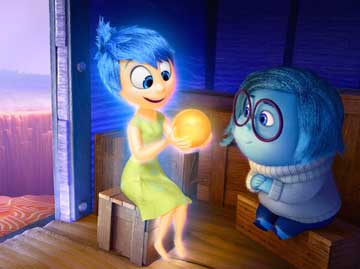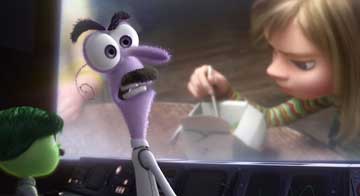Inside Out
by Jordan Canahai

There’s a delightful hubris motivating Pete Docter’s Inside Out, drawing on a premise that seems inspired by the ingenious screenwriting of Charlie Kaufmann and made up of images which recall the elemental humanist power of Spielberg or Miyazaki. The latest from Pixar studios, and their best since Docter’s previous Up, offers an ambitious and comic take on the inner workings of a child’s mind. The film centers on a loveable group of five colored humanoids who represent the emotions of Riley (Kaitlyn Dias), managing the preteen’s thoughts via a control panel in the center of her brain. Led by the effervescent Joy (Amy Poehler), the group—which includes Sadness (Phyllis Smith), Fear (Bill Hader), Anger (Lewis Black), and Disgust (Mindy Kaling)—guides Riley through her days, creating memories, symbolized by shiny orbs colored to match the emotion associated with them (red is angry, yellow is happy, blue is sad, etc.) and which, when examined, play back the captured moment like a home movie. Defining memories are carefully stored, but the majority get collected each day and sent into Long-Term Memory, a maze of shelves containing an orb for each moment in Riley’s life, where they may or may never be accessed again.


As the film begins, all has been going well for the group, as their leader Joy manages to put a happy spin on almost everything that comes Riley’s way, successfully subduing the other four emotions, especially Sadness. About the time that Riley’s loving mother (Diane Lane) and father (Kyle MacLachlan) move her from their comfortable home in Minnesota to a cramped little space in San Francisco, strange things begin to happen. At first, the formerly passive Sadness is found touching joyful yellow memories, turning them blue. Then, on Riley’s first day of school, as she introduces herself to her new class, Sadness strikes again, and Riley is left crying as she realizes her previous life is no more. This becomes the first core memory in Riley’s life dominated by sadness, and Joy’s attempts to dump the memory send her, Sadness, and all of Riley’s other core memories shooting out into the outskirts of Riley’s brain.
From here Docter successfully cross-cuts between the odd-couple quest of Joy and Sadness to make their way back to the control room with Riley’s core memories; the attempts of Fear, Anger, and Disgust to handle Riley’s day-to-day life, and Riley’s immediate experience of this mismanagement. The opposing interplay between Joy and Sadness takes on a familiar rhythm, while the antics of the increasingly overwhelmed Fear, Anger, and Disgust are madcap and amusing. Most intriguing, however, is how this split in Riley’s emotions affects her daily existence, as the formerly winsome and carefree Riley falls sullen and silent, confusing both herself and her parents, and bringing about knowing recognition in the audience. Who hasn’t felt those moments of doubt in life when joy seems gone, one’s self feels unstable, and one’s personality, once so familiar, seems to be slowly slipping away?
Docter’s inspired attempts to visualize various facets of the mind’s function are many, from explaining how annoying songs come to get stuck in one’s head, to literalizing a train of thought running from memory to the control room, to a brain freeze that turns the control room to ice, to an amusing sequence that finds Joy and Sadness stumbling into the place where Riley’s dreams are made (a movie studio, obviously). Between long-term memory and the elevated control room where Joy and the others work lie Riley’s Personality Islands—theme park-like structures representing her love of family, hockey, honesty, and goofiness. In one scene Riley tries out for a local hockey league, but with her emotions out of sync, she misses a shot, falls flat on the ice, and storms off in a tantrum, causing the personality island devoted to hockey to crumble into the void below. Children will be able to respond to moments like this, even if they might not fully grasp them. Adults on the other hand are likely to reflect on their own inner lives, likely filled with crumbled islands, whether eroded by fate, luck, or our own weakness and inability. Life, suggests Inside Out, is destined to include disappointment.
It’s also meant to include loss, as Joy and Sadness learn when they come across an unlikely ally in the magenta colored, elephant-like Boing Boing (Richard Kind), Riley’s forgotten imaginary friend, wandering lost in the halls of long-term memory. In a sequence that ranks as one of the most radical in American animation since Fantasia, Boing Boing leads them on a shortcut through Abstract Thought, which finds our heroes in a blank white space and morphed into cubist figures, flat 2D forms, and then, finally, simple colored lines as they rush to the exit before being rendered into nothingness. Boing Boing’s bittersweet end in the story finds Sadness comforting him through his acceptance that he has no place in the life of an eleven year-old girl.
Pixar’s usual trademarks are on display here; charming, imaginative animated worlds, character arcs which conclude with self-acceptance and personal actualization, villains that aren’t so villainous once seen up close, a climactic chase scene. Inside Out contains all these things, yet feels not like it’s geared toward children, but rather the child inside every adult, concerned as it is with the vital coming-of-age moment when one realizes that joy and sadness need not be two opposites constantly clashing, but rather they coexist as necessary dualities of life. It’s a lovely lesson from a lovely film. Pixar may never make a movie aimed exclusively at adults, but Inside Out comes as close as they’ve gotten to date.
Watch the trailer for Inside Out
|
Issue Navigation> Issue Index > v14n25 (Week of Thursday, June 25) > Inside Out This Week's Issue • Artvoice Daily • Artvoice TV • Events Calendar • Classifieds |









 Current Issue
Current Issue